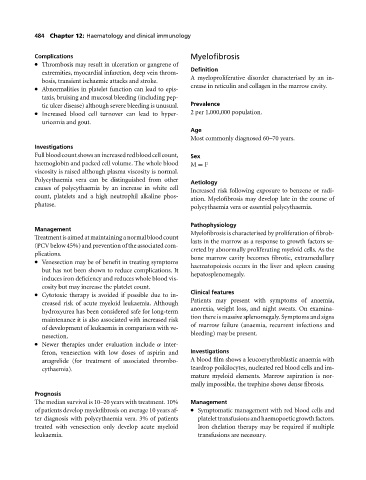Page 488 - Medicine and Surgery
P. 488
P1: KOA
BLUK007-12 BLUK007-Kendall May 12, 2005 20:37 Char Count= 0
484 Chapter 12: Haematology and clinical immunology
Complications Myelofibrosis
Thrombosis may result in ulceration or gangrene of
Definition
extremities, myocardial infarction, deep vein throm-
Amyeloproliferative disorder characterised by an in-
bosis, transient ischaemic attacks and stroke.
crease in reticulin and collagen in the marrow cavity.
Abnormalities in platelet function can lead to epis-
taxis, bruising and mucosal bleeding (including pep-
tic ulcer disease) although severe bleeding is unusual. Prevalence
Increased blood cell turnover can lead to hyper-
2per 1,000,000 population.
uricemia and gout.
Age
Most commonly diagnosed 60–70 years.
Investigations
Fullbloodcountshowsanincreasedredbloodcellcount, Sex
haemoglobin and packed cell volume. The whole blood M = F
viscosity is raised although plasma viscosity is normal.
Polycythaemia vera can be distinguished from other
Aetiology
causes of polycythaemia by an increase in white cell Increased risk following exposure to benzene or radi-
count, platelets and a high neutrophil alkaline phos- ation. Myelofibrosis may develop late in the course of
phatase. polycythaemia vera or essential polycythaemia.
Pathophysiology
Management
Myelofibrosis is characterised by proliferation of fibrob-
Treatment is aimed at maintaining a normal blood count
lasts in the marrow as a response to growth factors se-
(PCV below 45%) and prevention of the associated com-
creted by abnormally proliferating myeloid cells. As the
plications.
bone marrow cavity becomes fibrotic, extramedullary
Venesection may be of benefit in treating symptoms
haematopoiesis occurs in the liver and spleen causing
but has not been shown to reduce complications. It
hepatosplenomegaly.
induces iron deficiency and reduces whole blood vis-
cosity but may increase the platelet count.
Clinical features
Cytotoxic therapy is avoided if possible due to in-
Patients may present with symptoms of anaemia,
creased risk of acute myeloid leukaemia. Although
anorexia, weight loss, and night sweats. On examina-
hydroxyurea has been considered safe for long-term
tion there is massive splenomegaly. Symptoms and signs
maintenance it is also associated with increased risk
of marrow failure (anaemia, recurrent infections and
of development of leukaemia in comparison with ve-
bleeding) may be present.
nesection.
Newer therapies under evaluation include α inter-
feron, venesection with low doses of aspirin and Investigations
anagrelide (for treatment of associated thrombo- Ablood film shows a leucoerythroblastic anaemia with
cythaemia). teardrop poikilocytes, nucleated red blood cells and im-
mature myeloid elements. Marrow aspiration is nor-
mally impossible, the trephine shows dense fibrosis.
Prognosis
The median survival is 10–20 years with treatment. 10% Management
of patients develop myelofibrosis on average 10 years af- Symptomatic management with red blood cells and
ter diagnosis with polycythaemia vera. 3% of patients platelettransfusionsandhaemopoeticgrowthfactors.
treated with venesection only develop acute myeloid Iron chelation therapy may be required if multiple
leukaemia. transfusions are necessary.

